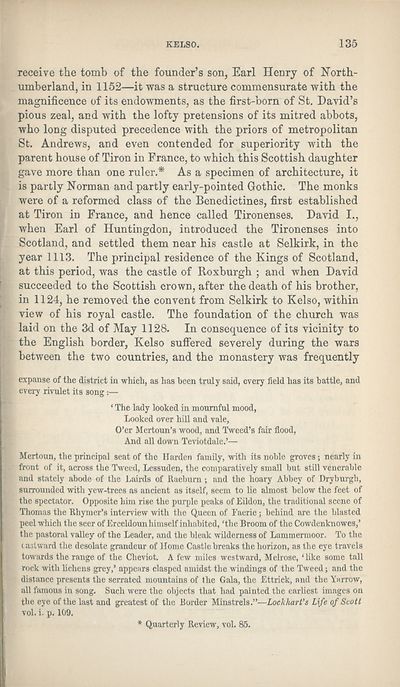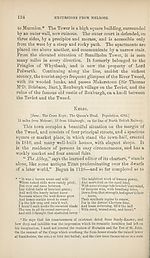Download files
Complete book:
Individual page:
Thumbnail gallery: Grid view | List view

KELSO.
135
receive the tomb of the founder’s son, Earl Henry of North¬
umberland, in 1152—it was a structure commensurate with the
magnificence of its endowments, as the first-born of St. David’s
pious zeal, and with the lofty pretensions of its mitred abbots,
who long disputed precedence with the priors of metropolitan
St. Andrews, and even contended for superiority with the
parent house of Tiron in France, to which this Scottish daughter
gave more than one ruler.* As a specimen of architecture, it
is partly Norman and partly early-pointed Gothic. The monks
were of a reformed class of the Benedictines, first established
at Tiron in France, and hence called Tironenses. David I.,
when Earl of Huntingdon, introduced the Tironenses into
Scotland, and settled them near his castle at Selkirk, in the
year 1113. The principal residence of the Kings of Scotland,
at this period, was the castle of Roxburgh ; and when David
succeeded to the Scottish crown, after the death of his brother,
in 1124, he removed the convent from Selkirk to Kelso, within
view of his royal castle. The foundation of the church was
laid on the 3d of May 1128. In consequence of its vicinity to
the English border, Kelso sufiered severely during the wars
between the two countries, and the monastery was frequently
expanse of the district in which, as has been truly said, every field has its battle, and
every rivulet its song
‘ The lady looked in mournful mood,
Looked over hill and vale.
O’er Mertoun’s wood, and Tweed’s fair flood,
And all down Teviotdale.’—
Mertoun, the principal seat of the Harden family, with its noble groves; nearly in
front of it, across the Tweed, Lessuden, the comparatively small but still venerable
and stately abode of the Lairds of Raeburn ; and the hoary Abbey of Dryburgh,
surrounded with yew-trees as ancient as itself, seem to lie almost below the feet of
the spectator. Opposite him rise the purple peaks of Eildon, the traditional scene of
Thomas the Rhymer’s interview with the Queen of Faerie; behind are the blasted
peel which the seer of Erceldoun himself inhabited, ‘the Broom of the Cowdenknowes,’
the pastoral valley of the Leader, and the bleak wilderness of Lammermoor. To the
eastward the desolate grandeur of Home Castle breaks the horizon, as the eye travels
towards the range of the Cheviot. A few miles westward, Melrose, ‘ like some tall
rock with lichens grey,’ appears clasped amidst the windings of the Tweed; and the
distance presents the serrated mountains of the Gala, the Ettrick, and the Yarrow,
all famous in song. Such were the objects that had painted the earliest images on
the eye of the last and greatest of the Border Minstrels.”—Lockhart’s Life of Scott
vol. i. p. 109.
Quarterly Review, vol. 85.
135
receive the tomb of the founder’s son, Earl Henry of North¬
umberland, in 1152—it was a structure commensurate with the
magnificence of its endowments, as the first-born of St. David’s
pious zeal, and with the lofty pretensions of its mitred abbots,
who long disputed precedence with the priors of metropolitan
St. Andrews, and even contended for superiority with the
parent house of Tiron in France, to which this Scottish daughter
gave more than one ruler.* As a specimen of architecture, it
is partly Norman and partly early-pointed Gothic. The monks
were of a reformed class of the Benedictines, first established
at Tiron in France, and hence called Tironenses. David I.,
when Earl of Huntingdon, introduced the Tironenses into
Scotland, and settled them near his castle at Selkirk, in the
year 1113. The principal residence of the Kings of Scotland,
at this period, was the castle of Roxburgh ; and when David
succeeded to the Scottish crown, after the death of his brother,
in 1124, he removed the convent from Selkirk to Kelso, within
view of his royal castle. The foundation of the church was
laid on the 3d of May 1128. In consequence of its vicinity to
the English border, Kelso sufiered severely during the wars
between the two countries, and the monastery was frequently
expanse of the district in which, as has been truly said, every field has its battle, and
every rivulet its song
‘ The lady looked in mournful mood,
Looked over hill and vale.
O’er Mertoun’s wood, and Tweed’s fair flood,
And all down Teviotdale.’—
Mertoun, the principal seat of the Harden family, with its noble groves; nearly in
front of it, across the Tweed, Lessuden, the comparatively small but still venerable
and stately abode of the Lairds of Raeburn ; and the hoary Abbey of Dryburgh,
surrounded with yew-trees as ancient as itself, seem to lie almost below the feet of
the spectator. Opposite him rise the purple peaks of Eildon, the traditional scene of
Thomas the Rhymer’s interview with the Queen of Faerie; behind are the blasted
peel which the seer of Erceldoun himself inhabited, ‘the Broom of the Cowdenknowes,’
the pastoral valley of the Leader, and the bleak wilderness of Lammermoor. To the
eastward the desolate grandeur of Home Castle breaks the horizon, as the eye travels
towards the range of the Cheviot. A few miles westward, Melrose, ‘ like some tall
rock with lichens grey,’ appears clasped amidst the windings of the Tweed; and the
distance presents the serrated mountains of the Gala, the Ettrick, and the Yarrow,
all famous in song. Such were the objects that had painted the earliest images on
the eye of the last and greatest of the Border Minstrels.”—Lockhart’s Life of Scott
vol. i. p. 109.
Quarterly Review, vol. 85.
Set display mode to:
![]() Universal Viewer |
Universal Viewer | ![]() Mirador |
Large image | Transcription
Mirador |
Large image | Transcription
| Antiquarian books of Scotland > Scotland/Scots > Black's picturesque tourist of Scotland > (195) |
|---|
| Permanent URL | https://digital.nls.uk/130030530 |
|---|
| Description | Thousands of printed books from the Antiquarian Books of Scotland collection which dates from 1641 to the 1980s. The collection consists of 14,800 books which were published in Scotland or have a Scottish connection, e.g. through the author, printer or owner. Subjects covered include sport, education, diseases, adventure, occupations, Jacobites, politics and religion. Among the 29 languages represented are English, Gaelic, Italian, French, Russian and Swedish. |
|---|

